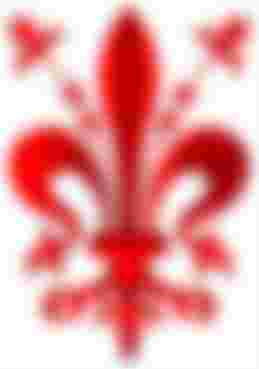I. Fleur-de-lis
We will start with a look at Fleur-de-lis. It is a symbol occurring in heraldry and on flags, where it is commonly associated with France or shows some French connection. However, the symbol occurred long before that in the symbology of old cultures as ancient Egypt, India, Babylonia, and Persia, and it was used in Middle Age Balkan and Eastern Europe, where it still can be found in flags and arms of some cities and other local entities. It is impossible to say where it started or what it really depicted in various periods and places. But where and when did it become the fleur-de-lis (or fleur-de-lys) of the French, and what flower is it really?

In French, fleur-de-lis literally means “lily flower”, but it is a matter of doubt if it really is a lily. Perhaps the word “lis” does not mean “lily” at all, but refers to something entirely different. Let's see what some sources have to say about that.
First Pierre-Augustin Boissier de Sauvages, 18th-century French naturalist and lexicographer:
“The old fleurs-de-lis, especially the ones found in our first kings' sceptres, have a lot less in common with ordinary lilies than the flowers called flambas [in Occitan], or irises, from which the name of our own fleur-de-lis may derive. What gives some colour of truth to this hypothesis that we already put forth, is the fact that the French or Franks, before entering Gaul itself, lived for a long time around the river named Leie in the Flanders. Nowadays, this river is still bordered with an exceptional number of irises - as many plants grow for centuries in the same places-: these irises have yellow flowers, which is not a typical feature of lilies but fleurs-de-lis. It was thus understandable that our kings, having to choose a symbolic image for what later became a coat of arms, set their minds on the iris, a flower that was common around their homes, and is also as beautiful as it was remarkable.
They called it, in short, the fleur-de-lis, instead of the flower of the river of lis. This flower, or iris, looks like our fleur-de-lis not just because of its yellow colour but also because of its shape: of the six petals, or leaves, that it has, three of them are alternatively straight and meet at their tops. The other three on the opposite, bend down so that the middle one seems to make one with the stalk and only the two ones facing out from left and right can clearly be seen, which is again similar with our fleurs-de-lis, that is to say exclusively the one from the river Luts whose white petals bend down too when the flower blooms.”
Heraldist François Velde says:
“However, a hypothesis ventured in the 17th c. sounds very plausible to me. One species of wild iris, the Iris pseudacorus, yellow flag in English, is yellow and grows in marshes (cf. the azure field, for water). Its name in German is Lieschblume (also gelbe Schwertlilie), but Liesch was also spelled Lies and Leys in the Middle Ages. It is easy to imagine that, in Northern France, the Lieschblume would have been called "fleur-de-lis." This would explain the name and the formal origin of the design, as a stylized yellow flag. There is a fanciful legend about Clovis which links the yellow flag explicitly with the French coat of arms.”
In 1722, Alexander Nesbit discussed the oriflamme:
“The other lilies, as those of France, so well known [..] having only but three leaves, is by the Latins called flos iridis, and by the French fleur de l'iris; being always called the flower of the rainbow or iridis, which the French call fleur-de-lis, from the river Lis, as some will; and anciently flams or flambs, which signifies the same: Whence the Royal Standard of France was called the oriflam or oriflambe, being a blue banner, charged with golden flower-de-luces, a suitable figure, say some, for the Franks, who come from the marshes of Friezland.”
It should be noted that the iris was referred to as a “lily” until some time in the 19th century, so the confusion about the flower is not so strange.

Another view holds that the lilies are derived from a baptismal lily used in Clovis' crowning – after which it became a symbol of the purity (in a Christian sense) of French royalty and a mark that their authority came directly from God. Clovis founded the Merovingian dynasty and lived about 466–511 AD.
Nothing of this is historically verifiable. It is more likely that the lily, which were early a Christian symbol of the Virgin Mary, was introduced in the royal symbology by Louis VI and Louis VII in the 12th century. A symbol of their divine right (to rule).
Here we can see the coat of arms of France Ancienne (left), Azure semé-de-lis Or. In 1376, Charles V changed the design to a shield with only 3 lilies (middle). This pattern, later with a white background, was used on the flag of France until the French revolution. A symbol of the Kingdom and of the Royal Dynasty.

The Catholic church also used, and still uses, the Fleur-de-lis. Above (right) is the coat of arms of the relatively recent Pope Paul VI.
Quite many modern flags - especially local flags in France and in areas influenced by French culture, such as certain parts of Canada and the United States - display a pattern with fleurs-de-lis. Here are a few examples: Top left, Lyon; top right, Detroit; boom left, Quebec; bottom right, New Orleans.

Finally, let's look at an error committed by Albrecht Dürer, in Charlemagne. The coats of arms symbolise Germany (left) and France (right). However, it shows the new French design, which wasn't created until 1376, centuries after the life of Charlemagne, who lived 742-814.

II: The Lily (giglio) of Florence
”I saw Florence in such calm repose, with these men and others like them, that she had no reason for grief. I saw her people, so glorious and just, with these men to serve them, that her arms of the white lily were never reversed on the standard, nor the lily dyed red by division.” (Dante Alighieri)

This is the lily, giglio, that can be found on the coat of arms of Florence, in Italy. It is very similar to a fleur-de-lis, but has a different history. Indeed, the two lilies seem not to be related.
There are many stories about this symbol and its origin. One connects it to when the Romans founded the city, Florentia, and the celebration of the goddess Flora. Another story refers to the death of Fiorino, a Roman praetor. He died when Fiesole was attacked.
In reality, there is no evidence that this was a symbol of Florence before the 12th century. The Florentines carried the Giglio in the the battles of the first crusade. The first symbol, however, was a white lily on a red background. The colours were reversed in 1266, when the Guelph party wanted to mark their victory over the Ghibellines.
According to Roman mythology, the lily came from a drop of milk falling from the breast of the goddess Juno. (Compare that to the Christian view that the first lily was born from the tear of Eve when she had to leave the Garden of Eden.)
The Florentine lily is an iris, the Giaggiolo, also called Orris root or Florentine iris.
Copyright © 2017, 2021 Meleonymica/Mictorrani. All Rights Reserved.
You find my articles related to symbols here, and to history here.
Interested in history, legends and myths, join my community History, Myths, Legends & Mysteries (be45).
You find all my writings on Read.Cash, sorted by topic, here.





